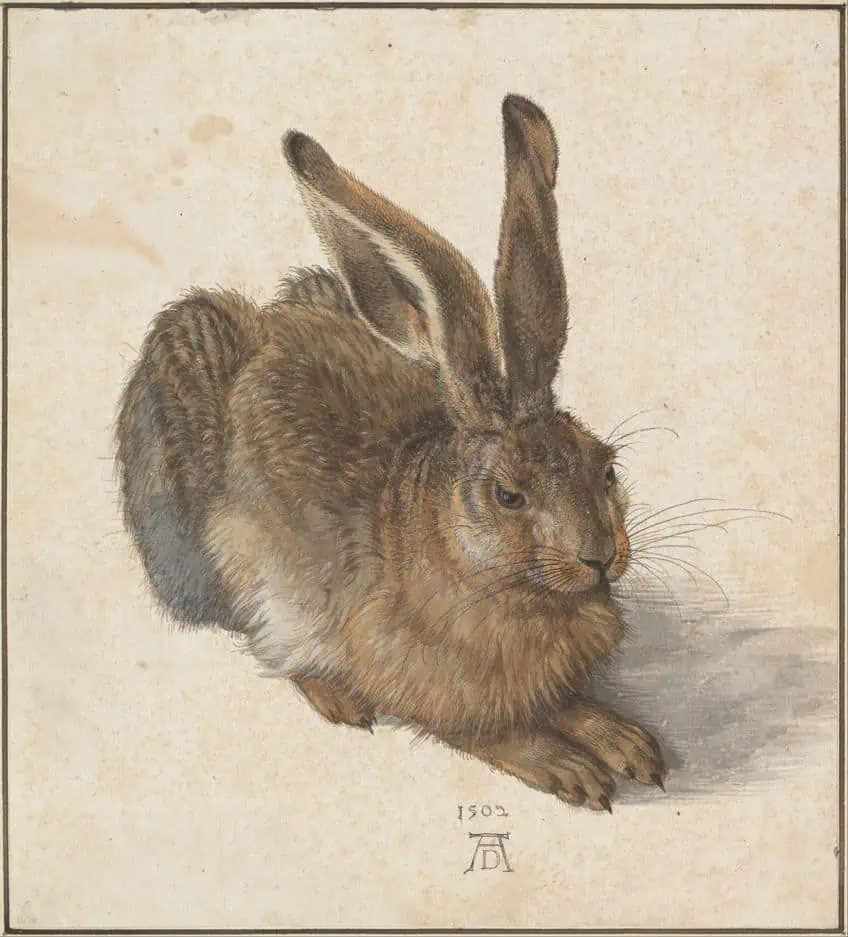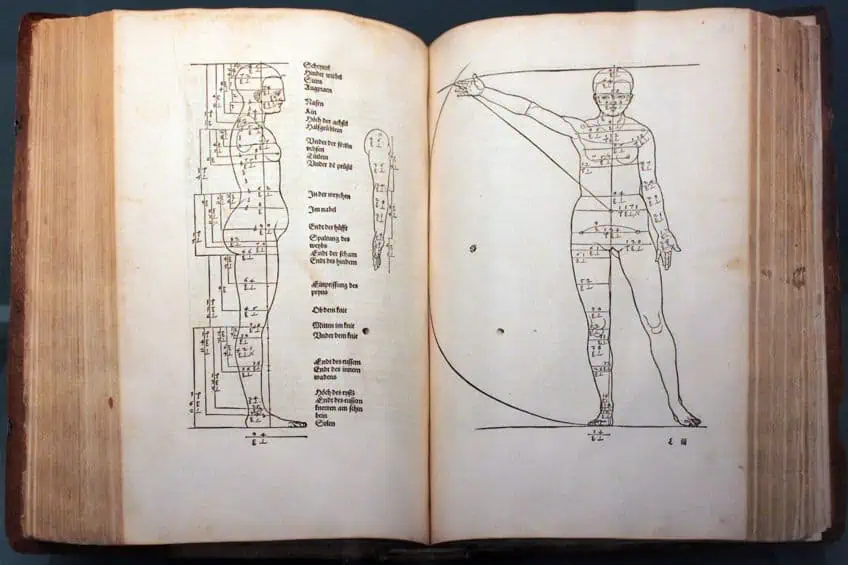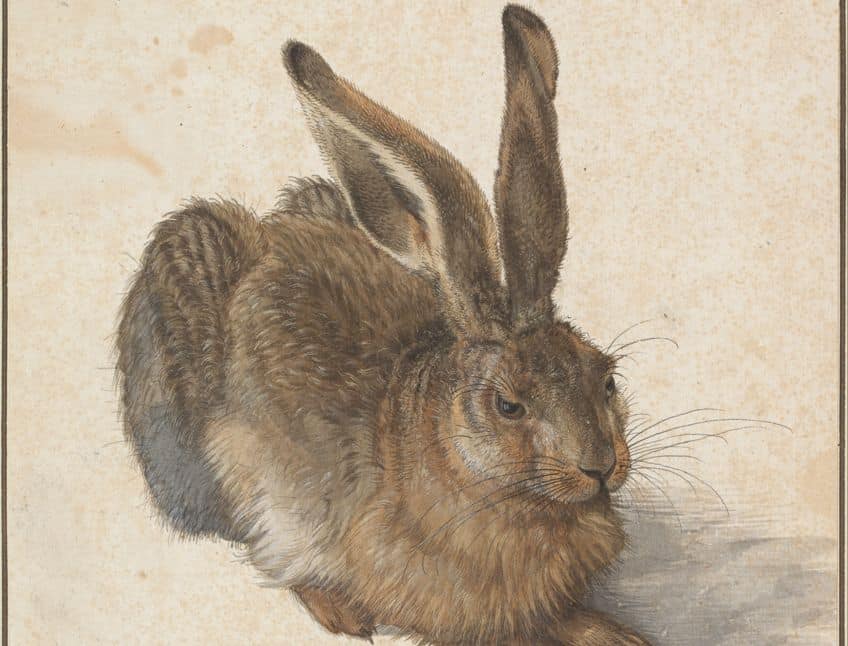“Young Hare” by Albrecht Dürer – Dürer’s Rabbit Analysis
Young Hare by Albrecht Dürer, the renowned German artist, is a watercolor painting originally produced in 1502. Dürer’s rabbit painting is regarded as a masterwork of observational art. The subject is depicted nearly photographically realistic, and while the painting is generally titled Young Hare by Albrecht Dürer, the image is realistic enough for the hare to be confirmed as a mature individual. Let’s have a look at the Young Hare analysis and history.
Contents
Understanding the Young Hare by Albrecht Dürer
| Artist | Albrecht Dürer (1471 – 1528) |
| Date Completed | 1502 |
| Medium | Watercolor |
| Dimensions (cm) | 25 x 22 |
| Current Location | Albertina, Vienna, Austria |
To the layperson, this may just look like an ordinary painting of a rabbit. But much thought and effort went into the creation of Dürer’s rabbit. Dürer had to adjust the normal shading standards to convey the shape of the rabbit by the falling of light over the body since the hare’s fur laid in distinct ways and the creature was speckled with brighter and darker spots all around.

Regardless of the technical difficulties in conveying the impression of light with a multi-colored, multi-textured figure, Dürer not only created a thorough, almost scientific investigation of the rabbit but also infused the image with a warm golden illumination that hits the rabbit from the left, outlining the ears and the hair all along hare’s body, providing the pupil a spark of life, and throwing a peculiar shadow to the right-hand side. But before we go any further into our Young Hare analysis, let’s first learn a bit about the artist himself.
Albrecht Dürer (1471 – 1528)
| Artist | Albrecht Dürer |
| Nationality | German |
| Date of Birth | 21 May 1471 |
| Date of Death | 6 April 1528 |
| Place of Birth | Nuremberg, Free Imperial City of Nuremberg, Holy Roman Empire |
Albrecht Dürer was born in Nuremberg and began his career as a goldsmith at his father’s workshop. Dürer’s brilliance was evident early on, and both his proficiency as an artist and his self-awareness were exceptional for the period. The spread of the plague in Nuremberg in August 1494 prompted the artist to flee the city. Dürer traveled to Venice via Innsbruck, Augsburg, the Brenner pass, the Eisack valley, and Trent. His journey, which lasted until the spring of 1495, was invaluable.
Dürer got familiar with painters like Giovanni and Gentile Bellini and studied the works of Antonio Pollaiuolo, Andrea Mantegna, and Lorenzo de Credi, frequently by reproducing them.
Dürer returned to Nuremberg in 1495 and began a career as a printer and painter. He was an instant success, earning contracts for his paintings. The plague returned to Nuremberg in the summer of 1505, and Dürer set off for Venice once more. This time, though, he came as a well-known artist recognized for his engravings and woodcuts. Dürer lived in Nuremberg from 1507 until 1520, with the exception of a few brief travels. His painting periods were interspersed with times when his graphic work attracted more interest.
Dürer drew the attention of Emperor Maximilian I, who toured Nuremberg in February 1512 and later offered Dürer additional assignments, including the marginal illustrations for his liturgical texts, to which other painters contributed. Following Maximilian I’s death, Dürer traveled to the Netherlands with his wife and a maid in order to have his pension approved by Charles V. Dürer got more absorbed in his theoretical works in his latter years. On the 31st of October, 1528, his final and most important dissertation, Four Books on Human Proportion, was later published after his passing.

Several painted and etched portraits were created during these years, but the most significant work is the Four Apostles, which was given to the city council in Nuremberg in 1526. Inscriptions accompany the Apostles Peter and Paul, John the Evangelist, and Mark the Evangelist, cautioning against false prophets. The apostles are widely accepted to represent the Four Temperaments, but there is less agreement on the extent to which the panels reflect Dürer’s Lutheranism or his worry about the Reformation’s excesses.
Young Hare Analysis
Albrecht Dürer’s rabbit is one of the most well-known and appreciated pieces in art history. It is neither a still life painting nor is it a picture of a dead animal, as is common in many other paintings from the same period. Dürer deviated from standard Renaissance genres to produce an outstanding realistic picture of a common animal. The artwork lacks any symbolism that may have been useful to Dürer or his contemporaries, nor does the hare allude to any religious or mythical subject matter. The animal is shown completely independently – as a juvenile hare.
Individual hairs are produced with a broader range of hues and delicate brushwork, while Dürer softly drew the picture and underpainted it with dark watercolor washes. The texture of the fur was then meticulously built up with a combination of light and dark brushstrokes in both watercolor and body color. The texture has been skilfully built up to the point that you can nearly feel the softness of the fur.
Take note of the hare’s perked-up ears – additional detail that brings the animal to life. Lastly, the paws, and the image in the animal’s pupil complete, or should we say perfect, the image!
Animals did not become an acknowledged genre in art until the 17th century. In other words, until then, relatively few artists tackled it since many believed it couldn’t adequately transmit their creative vision to the audience. Albrecht Dürer was one of the first painters to see animals as a subject worthy of study and attention. He was attracted by the natural world and the underlying truths it concealed, and he most likely made many of these paintings for sheer delight and inquiry. It occurred during the Age of Discovery, when explorers returned from distant regions to Europe with instances and pictures of new species, piquing interest in the world of exotic and indigenous animals and plants.

The artist’s other paintings, sketches, and prints all show concern for minute detail and depict the texture and structure of a wide range of creatures. Some argue that Dürer properly reproduced the picture of the hare by sketching one in the wild and filling in the individual characteristics from a dead hare, or by capturing one and keeping it alive in his workshop while he labored on the work.
A projection of the window frame in the rabbit’s eye is usually claimed as proof that Dürer replicated the hare from life in his studio, although this cross-barred reflection is a technique that he commonly utilized to bring liveliness to his figures’ eyes.
Albrecht Dürer used his watercolor studies as references for his printed works, but the animals in The Holy Family with Three Hares are minimally rendered, and the rabbit is backing away, half-hidden beside Eve’s legs, in the sole other print featuring a rabbit, Adam and Eve, the 1504 copperplate engraving. The large date and Dürer monogram on the Young Hare shows that Dürer saw it as a finished piece rather than a preparatory drawing. The picture spawned multiple reproductions, at least 12 of which are known to exist today.
Albrecht Dürer, a German artist, produced Young Hare. It was completed at the artist’s studio in 1502 and is widely regarded as a masterpiece of observational painting. The actual animal depicted has been identified as an adult specimen, despite being given the title of Young Hare in English. Albrecht Dürer founded a workshop in Nuremberg upon his return to Germany in 1495, where he produced this artwork and many other notable works.
Frequently Asked Questions
Who Produced the Young Hare Painting?
Albrecht Dürer was a printmaker, engraver, theoretician, and mathematician, in addition to being a painter from Germany. He was in his 20s when his prints first acquired acclaim across Europe, propelling him to the status of one of the greatest Northern Renaissance painters and printers. He is widely renowned for adopting shading norms, particularly in this picture.
What Does the Young Hare by Albrecht Dürer Depict?
The artwork was completed around 1502, when the artist returned to Nuremberg from his first journey to Italy. The picture was produced with both gouache and watercolor, two of his favorite techniques. The picture portrays a lone hare, yet others have speculated as to how the image was captured so precisely. Some say he drew wild hares before filling in the fur details with a dead animal, while others believe he trapped a rabbit and kept it in his studio. Albrecht Dürer created an incredibly realistic and precise depiction of a hare, speckled with darker and lighter areas with hair pointing in all directions. The image is pleasant, with a golden light striking the hare on the left-hand side, accentuating the ears, shining on the fur along the left side, and bringing a sense of vitality to the rabbit’s eyes. Some people think that the reflection in the eyes means that the animal was alive when it was painted.
Nicolene Burger, a South African multimedia artist and creative consultant, specializes in oil painting and performance art. She earned her BA in Visual Arts from Stellenbosch University in 2017. Nicolene’s artistic journey includes exhibitions in South Korea, participation in the 2019 ICA Live Art Workshop, and solo exhibitions. She is currently pursuing a practice-based master’s degree in theater and performance. Nicolene focuses on fostering sustainable creative practices and offers coaching sessions for fellow artists, emphasizing the profound communicative power of art for healing and connection. Nicolene writes blog posts on art history for artfilemagazine with a focus on famous artists and contemporary art.
Learn more about Nicolene Burger and about us.
Cite this Article
Nicolene, Burger, ““Young Hare” by Albrecht Dürer – Dürer’s Rabbit Analysis.” artfilemagazine – Your Online Art Source. February 27, 2023. URL: https://artfilemagazine.com/young-hare-by-albrecht-durer/
Burger, N. (2023, 27 February). “Young Hare” by Albrecht Dürer – Dürer’s Rabbit Analysis. artfilemagazine – Your Online Art Source. https://artfilemagazine.com/young-hare-by-albrecht-durer/
Burger, Nicolene. ““Young Hare” by Albrecht Dürer – Dürer’s Rabbit Analysis.” artfilemagazine – Your Online Art Source, February 27, 2023. https://artfilemagazine.com/young-hare-by-albrecht-durer/.



